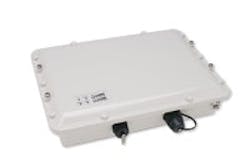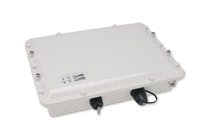Dual-Radio Outdoor Access Point
The growth of wireless network deployment in industry requires that the components that support these networks be capable of operating dependably in harsh environments far beyond whats needed to support, for example, a university campus or commercial distribution site WLAN.
Aruba Networks says its new AP-85 dual-radio outdoor access point incorporates many unique radio, packaging and operational features that will benefit users with petrochemical, material handling, mining, food processing and shop-floor applications.
Since most AP-85 access points will be mounted out of reach, the device is software-configurable and updatable over the network, says Michael Tennefoss, Arubas head of strategic marketing. Should operational requirements change after the AP-85 is installed, the device can be repurposed as a wireless mesh link or intrusion-detection sensor via software download without physically accessing the unit. When configured for mesh link operation, the radio signals hop from access point to access point, an ideal arrangement for telemetry, mining and oil/gas applications where wired networks might be impossible or expensive to install. The radios also can be configured redundantly for high availability mesh operation.
With outdoor or remote locations, flexible power options are important. Tennefoss says to simplify power delivery, the AP-85 can operate from standard 802.3af Power-over-Ethernet or 8-16 Vdc. In the latter case, low-voltage power can be drawn either from the same bus power source used for industrial sensors and actuators or from a solar panel, he says. The solar power option is especially useful in wireless mesh link applications where power connections arent otherwise available.
The data connection is 10/100BaseT auto-sensing via RJ-45, and an integrated console port is provided. To simplify maintenance, the AP-85 can be reset to factory default settings and adjusted over the air. This unique feature is especially important in harsh operating environments when it might be impossible to physically access the unit for troubleshooting, states Tennefoss.
Aruba says the AP-85 sports a ruggedly designed enclosure and mounting system. The device is IP68-rated and resistant to moisture and airborne contaminants, adds Tennefoss. The AP-85 can be exposed directly to the elements or washed down in food handling and brewing applications, will resist winds to 200 km/hour and will operate over a -30 to 55 °C range.
The ATEX Zone 2 rating enables the AP-85 to be operated in explosion-hazardous environments such as petrochemical plants, in which a mixture of air and flammable gas, vapor or mist is present. Tennefoss says high-intensity LEDs mounted behind a front panel window allow data, radio and power status to be checked at a distance, a time-saving feature when the equipment is mounted out of reach.
Dual, high-power 802.11n a/b/g radios are 4.9 GHz ready and deliver up to 200 mW (23dBm), says Tennefoss.
Two hundred milliwatts is substantially higher output power than typical outdoor Wi-Fi access points and allows a single access point to reliably cover a larger geographic area, he adds. Quad N-type female antenna interfaces support RF signal spatial diversity, a feature that increases the effective range of the access point by enhancing signal reception in difficult RF environments.
Taken all together, says Tennefoss, these features define a unique Wi-Fi access point, able to service a wide variety of industrial applications in very demanding environments.
For more information, call 408/227-4500, e-mail [email protected], or browse to arubanetworks.com/products/access_points.php.


